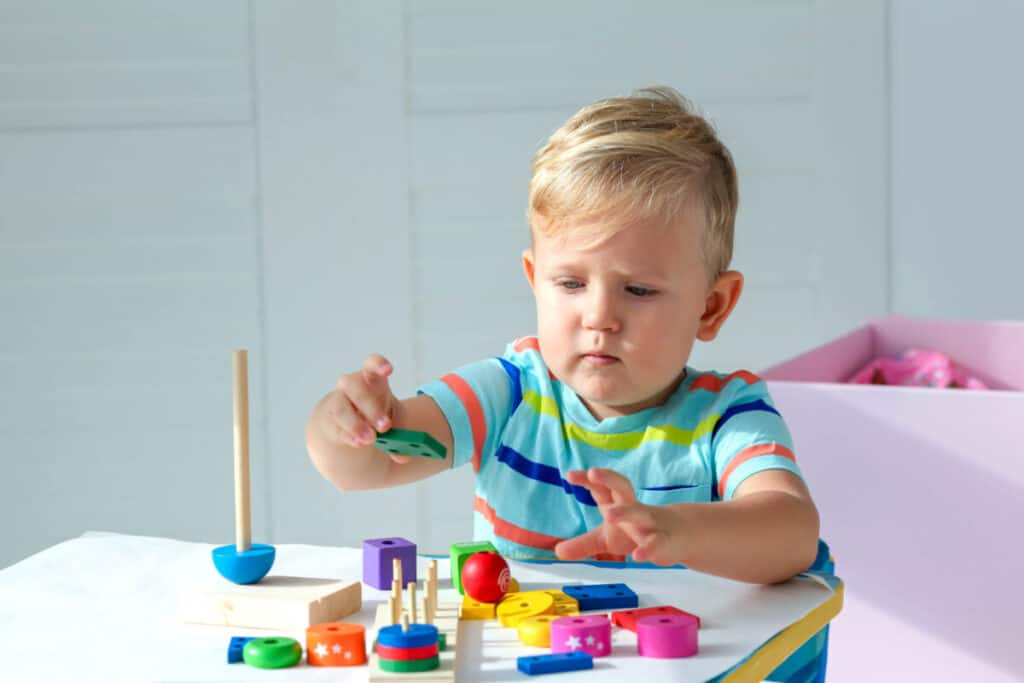People want to feel safe and comfortable in their space. Whether children are younger and learning to climb onto a bed or older and mastering cooking an omelet, kids want to identify how they feel comfortable and learn around others. People crave independence and safe experiences but must learn by trial and error before recognizing which struggles require help and which do not.
Teach children about the importance of personal space and boundaries by emphasizing safety and promoting communication. Use symbols, rooms, and objects to teach young children distance. Use measurements and gentle reminders for older independent children.
Parents must model safe behaviors and habits by recognizing their individual needs and creating space for themselves. Teach children to realize their talents, struggles, and feelings. Incorporate family listening routines to provide opportunities to reflect, listen, and engage in your family’s future goals. Help children modify their space to reflect their interests and provide organizational tools.

How to teach kids to respect personal space?
- Explain why to help them understand the reason. Children love to ask the simple question, “Why?” When you can, give them a brief answer so they begin or continue to learn about you and your personality. Kids want to see reasons to encourage space to try assessing their comfort levels. Learn about your needs to explain it to them as you comfort levels dictate your boundaries.
I am using a knife and I feel unsafe with you too close.
I want to go for a walk by myself to be with my brain and body.
- Practice making or creating visual markers that help them see where you would like them to stay distanced. Use things around your house they enjoy so they don’t feel attacked by the boundary. “I want to be two Lego boxes away while I am doing my project.” Try making a block line to encourage a short game with them or Use visuals like couches and doors so they can see where you want to be and where you would prefer they stay.
- Teach them distance and measurements by showing them where you want to be and use things to indicate the amount of space you want. Get out a tape measurer if you desire. Consider letting them play with the tape measurer so they learn different symbols and measuring skills. Take blue painter’s tape to tape on the floor if you want to make a visual barrier.
- Keep communicating your needs and encourage them to talk about their physical needs. Keep communication calm and non-judgmental to improve listening skills. People react to one another better when they feel that their boundary is understood and not just someone else pouncing on their goals. Try to stay as a matter of factly and objective to the scenario so children understand it is about space and safety.
- Look for books on the subject so the child can relate to a character and play out different scenarios in their heads. Take time when you feel overwhelmed or confused to look for ways to connect characters in stories to your real-life experience. Sometimes children and adults must learn through relating and feeling another situation to learn new words and methods for sucessful parent child communication.
- Try to redirect them to give them opportunities to engage in something unrelated to you to model this awareness. Provide them with materials or toys for a project they will enjoy. Ask another family member to help redirect the child if possible. It is in your best interest to communicate with other people when you truly need space or an opportunity to do something that you can not typically do around your child.
- Repeat what you say and continue to repeat it gently. Sometimes, kids have a difficult time remembering and understanding time and space. They forget that it has only been 5 minutes and not 30 minutes or that they accidentally sneaked their way into their room.
- Understand that even if you don’t feel entirely alone with yourself and your needs that you are planting seeds for your kids. Every small opportunity you engage with them and repeat is a learning experience for them. You may want time alone to do a chore or time to start a project. It might even feel like you did not get any time to yourself at all. Try to remember that the more time you spend on gentle reminders and safe boundaries, the more likely they will be to learn to listen.
- Stay true to word and agreements. Focus on owning the responsibility of your spatial needs and understand when a child asks for theirs, it is essential to agree that you understand their space. Follow through with activities and projects your promised your child. If you said you would do something after your time alone, make the effort to set aside time for them as well.
- Let your child dictate their spatial requests. You are a role model for your children and they want to see that what you do, they are worthy of. They will ask for space from you or a sibling and you should do your best to accommodate their needs.
- Have appropriate places available for them to be that is kid-friendly and easy for them to play in. Give them the option to feel comfortable and safe in their own area of a house so they are more likely to distance themselves from you. There should be safe toys, appropriately sized furniture, and ways to stay occupied.

Why is creating healthy boundaries essential for kids?
Children need a space to play, read, think, create, and be bored. Creating space improves self-worth and self-esteem. Boundaries keep us safe and confident while we learn to manage skills and process interests. Give yourself the option to stay safe and comfortable by modeling good habits and encourage your child to do the same.
Having the right environment promotes kid’s interests because they aren’t worried about other people and their goals. Children love to be in their minds and nourish what they have planted in their brains. Give your child to chance to learn by giving them their own space, distancing yourself when they ask, and communicating needs.
Children’s brains take in so much every day, and focusing inward helps decrease stimuli. Life is overwhelming, and children want to feel their own sensory experiences without concentrating on the chatter and movement from the evolving world around them. Decreasing stimuli teaches them to focus on their goals and interests because they aren’t processing the number to other senses simultaneously.
By teaching kids to create their own safe space, they learn to value other’s space. After a time, kids understand that they feel more themselves when they give themselves the chance to decompress and feel alone with thoughts, skills, and interests. They can apply that concept to others in their circle and are more likely to understand why others ask for space when they want to feel themselves.
Introducing this idea to children improves their mindfulness routines. They learn to be emotionally intelligent by processing situations and reflecting inward to focus on the body.
Some children want to be alone to be safe. Healthy boundaries are a human safety feature that we are all born with, and it’s essential to teach children to understand when they feel unsafe to remove themselves from that situation.
How to teach children to establish their own boundaries?
Children learn to establish boundaries when they feel respected and firm with their goals and objectives. Listen to them when they need space to show that their interests and needs matter. Use verbal responses that reinforce you value their freedom and indicate that you want to work on your life –cooking, cleaning, reading, bathing– while they learn to manage their bubble.
mom: You want to be alone with your coloring books today, I see. I will be in the laundry room.
Let them verbalize comfort levels and listen as they work in out in their heads. Children may need a few minutes to process what this space means for them. They might be confused because they want space but also might want an on-call parent. Continue to listen without interference so they can understand why they are worried about creating distance. It won’t be apparent for some children. Keep listening and asking questions to help them work through their comfort zones.
child: I want you here with me but not on my bed and not on the floor; on the carpet because it’s not too close.
Allow them to feel immense feelings as they arise to encourage solutions. While you work on helping your child process boundaries, allow them to express their emotions safely. They will scream, kick, and likely throw things, but giving them this experience prevents them from stuffing their feelings which distances people from their objective.
mom: You look very upset. I say you throw the coloring pencils. You are allowed to feel your big feelings. I will help you when I understand you better.
Identify confusing verbal responses that lead children and parents to believe the situation resolved itself. Kids say things quickly without realizing how fast parent’s response times will be. Sometimes, parents react more slowly, while other times, they quickly jump on an opportunity. Children can not gauge a response time until it happens. They confuse themselves by tiptoeing around topics they have difficulty explaining.
child: I wanted to make it fly and then you left but I can’t.
Recognize when you feel that an experience has made you uncomfortable. Children continue to stay frustrated and upset as they learn to feel comfortable with themselves and their skills. They might continue to learn about their surroundings and their feelings in uncomfortable ways. There is a high chance they will kick and scream while they feel their emotions because they feel safe approaching a new independent level. As a parent, you must own how you feel unsafe to show the child your comfort levels.
mom: You may be upset, but you may not throw pencils at my face. I will go do the laundry now to stay safe.
Strengthen active listening skills to learn more about what the child wants to accomplish, how they wish to attain their goals and the level of assistance they need. Try not to suggest solutions while you are listening. Just listen to them as they process their boundary levels and their task or game.
child: The wings are green and blue, but the red is okay and the purple is broken.

Decide how to distance yourself from a harmful experience, so they learn that it was uncomfortable for the parent and unsuccessful for the child. When kids try new things, they continue to assess comfort levels, motives, and outcomes. When something doesn’t work in the child’s favor, it is acceptable to say that it failed to work. Kids will try again. Teach them how you want to understand the child better. They might explain better with words or act out the scene again to show you how they wanted it to happen.
mom: I don’t want to be hurt by the pencils. If you are okay now, I will continue cleaning clothes.
Let children stumble over their words without correcting them quickly and continue to listen, so they learn to describe their struggles efficiently. Keep eye contact, a kind face, and a curious composure as they struggle to communicate their spatial strategy.
child: It’s all crumply on the top corner cloud and the part is too small here.
Kids may need to repeat their ideas multiple times before understanding how they want to make it happen. Continue repeating so the child verbalizes their mastery of skills. Remind the child what they have said to help them understand why they mentioned it. Stay curious! Ask questions.
mom: First you said, ‘I want to make it fly’ and then began to walk out the door. I heard that the purple is broken and the paper is crumply. Do you want me to sharpen the pencil or smooth the paper?
Embrace crying and frustration when kids feel understood and respected. Continue to learn about your child’s interests as they continue to describe their intent and their capabilities. Allow the eruption of immense feelings as they break through their wall to improve communication and establish boundaries for self-worth.
child: It’s the wing! The wing! It’s pointy here! Help me do it and then go to the clothes.
What is the best way to talk about personal space?
There are many uncomfortable situations that people tend to skim over. Use these opportunities to redirect attention to feelings instead of activities, projects, and motives. Action is different than the way that you feel. Be sure to identify and separate the sentiment from the objective and focus on the feeling before you attempt to encourage a task.
Promote weekly family time to bring up past experiences. Talk with the people you live with to teach them to tie together feelings from current situations with past experiences they may have ignored or suppressed. Use family listening times to spark dialogue and rehash old memories as you process new experiences together. Parents should model this behavior by expressing feelings, boundaries, and goals.
Recognize that animals outside do it! Learn from animal friends by observation. If an animal has the goal of eating and feels threatened by another creature, it will act a certain way to maintain its idea of eating. Describe the similarities we have with animals in respect to boundaries, safety, and survival. Talk about the differences to learn how people communicate, feel, and express differently than animals.
Observe and identify different ways that people model personal safety. Talk about different methods of protection you have witnessed during the family listening time to describe how other people have attempted to create a boundary. Describe the setting, the number of people involved, and some topics of discussion. Maybe you have neighbors that you play with often, a family you see at the store, or friends at a park your see frequently. Do not encourage disrespect or name-calling. Teach children to learn about behaviors and habits for survival through daily observations.
How does a child regulate their personal space?
Children want to be proud of the space they create for themselves. Teach them to be confident in the personal domain and comfortable with how it looks and feels. Encourage safety as you teach them to manage their belongings and show them different ways to organize their interests.
It will be messy for you but genuinely comfortable for them. It takes years for children to gain experiences and skills to recognize and adapt to their growing bodies and minds. Please try to stay calm when you see their areas. Consider designating one weekend a month that you help them organize, create structures, or separate toys and belongings.
